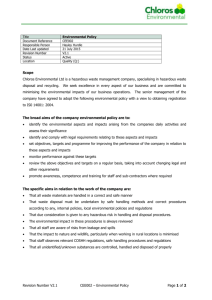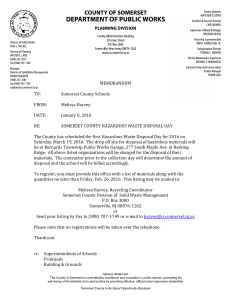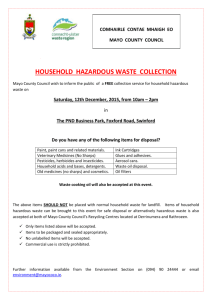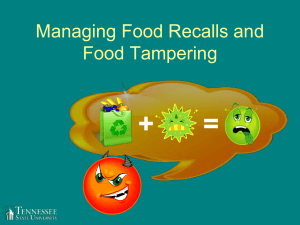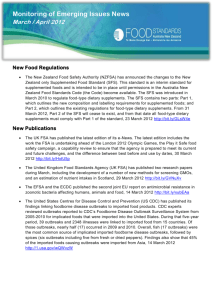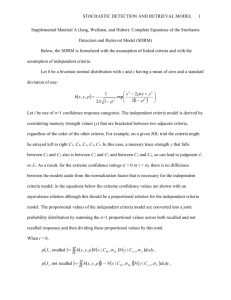CONSUMER SAFETY Disposal a murky issue in recall of lead
advertisement
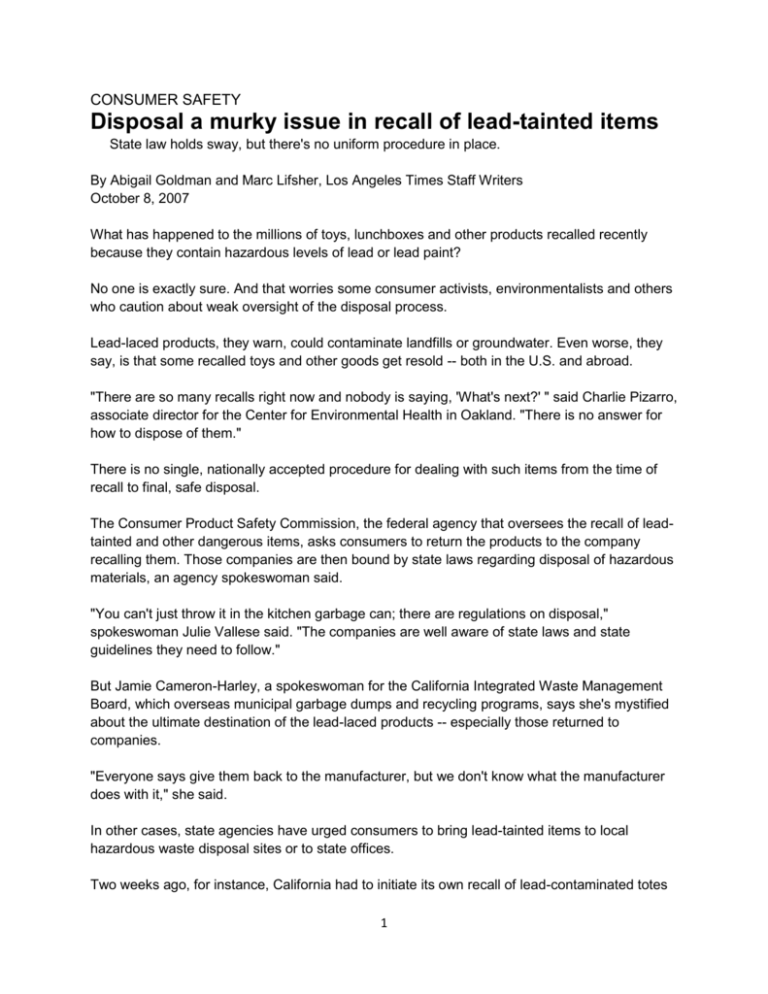
CONSUMER SAFETY Disposal a murky issue in recall of lead-tainted items State law holds sway, but there's no uniform procedure in place. By Abigail Goldman and Marc Lifsher, Los Angeles Times Staff Writers October 8, 2007 What has happened to the millions of toys, lunchboxes and other products recalled recently because they contain hazardous levels of lead or lead paint? No one is exactly sure. And that worries some consumer activists, environmentalists and others who caution about weak oversight of the disposal process. Lead-laced products, they warn, could contaminate landfills or groundwater. Even worse, they say, is that some recalled toys and other goods get resold -- both in the U.S. and abroad. "There are so many recalls right now and nobody is saying, 'What's next?' " said Charlie Pizarro, associate director for the Center for Environmental Health in Oakland. "There is no answer for how to dispose of them." There is no single, nationally accepted procedure for dealing with such items from the time of recall to final, safe disposal. The Consumer Product Safety Commission, the federal agency that oversees the recall of leadtainted and other dangerous items, asks consumers to return the products to the company recalling them. Those companies are then bound by state laws regarding disposal of hazardous materials, an agency spokeswoman said. "You can't just throw it in the kitchen garbage can; there are regulations on disposal," spokeswoman Julie Vallese said. "The companies are well aware of state laws and state guidelines they need to follow." But Jamie Cameron-Harley, a spokeswoman for the California Integrated Waste Management Board, which overseas municipal garbage dumps and recycling programs, says she's mystified about the ultimate destination of the lead-laced products -- especially those returned to companies. "Everyone says give them back to the manufacturer, but we don't know what the manufacturer does with it," she said. In other cases, state agencies have urged consumers to bring lead-tainted items to local hazardous waste disposal sites or to state offices. Two weeks ago, for instance, California had to initiate its own recall of lead-contaminated totes 1 handed out by the state Department of Public Health. Subsequently, the California Public Employees Retirement System found unsafe lead levels on some of the 600 similar lunch bags it gave away at orientation meetings. Both agencies urged people who had the bags either to return them to the place they got them or dispose of them at local centers for household hazardous waste -- where items such as batteries, oil-based paints and computer monitors also are supposed to go. But Pat Macht, a spokeswoman for the state pension system, said her agency hadn't been told what to do with any lunchboxes it gets back. "We're waiting for direction about how to dispose of them," she said. Lead paint has been banned in the United States since 1978 because lead poisoning can cause brain and neurological problems, particularly in children. According to experts, only a fraction of consumers actually return recalled products to manufacturers -- mostly big-ticket items that would be expensive to replace. Mattel, which has issued dozens of recalls of toys in recent years, said that, historically, about 6% of recalled products are returned. Several toy manufacturers were contacted for this article, but only Mattel would comment on its plans for returned lead-tainted products. The El Segundo-based company said it was still evaluating how best to handle returned products from its recalls of 2.2 million toys possibly contaminated with lead paint. RC2 Corp., the Illinois-based manufacturer that this year recalled more than 1.7 million Thomas & Friends wooden railway toys because of unsafe lead levels, said the company so far had gotten back about 70% of the 1.5 million toys it recalled in June. It wouldn't say what it was doing with them. Likewise, Oriental Trading Co., a Nebraska company that this year recalled 132,000 children's "religious fish necklaces," declined to discuss its disposal plans. Mattel said it planned to recycle as many components of its returned toys as possible, including selling or reusing zinc and some of the resins used to make the toys. Leftover remnants, including any lead, will be handled by outside companies hired for their expertise in recycling and safe disposal of those materials, said Jeff Denchfield, the company's senior director of global sustainability. Until then, because of pending litigation, returned products are being stored near some Mattel distribution centers in Southern California, Texas and New York, the company said. So far, tests of the recalled products found lead content below the state's threshold for 2 hazardous materials -- less than 1,000 parts per million, the company said. That puts Mattel in a better position than the state. Preliminary testing of the Department of Public Health's lunchboxes has found lead at 1,300 parts per million, which means that the containers must be classified as hazardous waste and that they are subject to special regulations for handling and disposal, said Maureen Gorse, director of the state Department of Toxic Substances Control. The classification means that the products cannot be stored for more than 90 days without an extraordinary special permit, Gorse said. They also must be shipped by specially licensed haulers to state-regulated recycling or disposal sites. In the meantime, the governor's office and the toxic substances control agency have ordered agencies to inventory items, such as lunchboxes, that have a high probability of containing lead, Gorse said. Under state and federal law, manufacturers, importers or owners of lead-tainted products are responsible for the items' disposal if they are determined to be hazardous waste. Even when lead-tainted products aren't considered hazardous, that doesn't mean dumping them in regular landfills is the best option, environmentalists say. "It's best to treat them for what they are, as a material that contains a toxic chemical and needs to be handled with care," said Tom Neltner, a lawyer and chemical engineer who serves as cochairman of the Sierra Club's National Toxics Committee. "But the most important thing is to get them away from kids and to keep them away from kids." Added Caroline Cox, research director for the Center for Environmental Health: "Lead doesn't go away, it's a metal -- it doesn't break down or transform into a nontoxic substance, it stays lead. We take lead from mines and disperse it across the environment. That's not a good thing for kids or anybody else." abigail.goldman@ latimes.com marc.lifsher@ latimes.com *** Beware: Recalled products resurface Many recalled products stay in circulation long after recalls have been announced -- either because sellers don't know about the problems or some choose to profit from them. Federal regulators said that a product recalled in the United States could not be sold here or exported elsewhere for sale. 3 If goods have been refused entry to this country, however, federal law doesn't bar manufacturers and importers from selling them elsewhere. The Consumer Product Safety Commission says it notifies the destination country about the problem. It's not just other countries that face the problem, however. In a study for the journal Injury Prevention, published in August, researchers found 190 auctions of recalled products on EBay in just a 30-day period. The study, which used a list of 150 randomly selected recalled children's products, found that most of those recalled items -- 70% -- ended up being sold. And a 1999 federal study found that 69% of 301 thrift stores surveyed were selling at least one hazardous product. EBay, which has policies prohibiting the sale of recalled goods, said last week it would send warnings to sellers who listed recalled products notifying them that they could be barred from using the site. --Abigail Goldman Copyright 2007 Los Angeles Times *** NOTICE: In accordance with Title 17 U.S.C. Section 107, this material is distributed, without profit, for research and educational purposes only. *** 4
